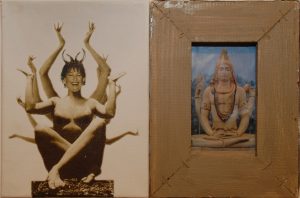Exhibition: “It’s a Wonderful Life”
12 March 2009
Curated by Edi Muka
For a while now, Lume Blloshmi is developing a new research in her artistic practice of exploring extra-pictorial dimensions. Not abandoning her origins as a painter, the artist revamps her practice by introducing elements of the ephemeral, selected by pure instinctive observation. Using satire and a Duschampian inspired nominalist approach, Lume Blloshmi constructs a small universe that, if looked at closely, has her at the centre with its characters spinning around like small dependable planets. The event was supported by FAVA foundation.
It’s a Wonderful Life…
…an old shelf, one of those from ”Enver’s time”, overfilled with glass jars, overfilled with ash and cigarette tubs. This is not the title of the Hollywood film by Frank Capra. It’s just the title of an exhibition, of an installation piece to be more precise, that gives the name to the entire solo show of Lume Blloshmi. It’s some sort of interactive monument, a kind of READYMADE, made by the people, consumers of those incredible amounts of cigarettes. Or to put it in other words, it’s a piece made by the crazy run of consumption and social passivity of Albanian society in these liberal times the country is going through. An awkward feeling captures you when looking at the object – first the wonder from the persistence with which the artist has collected for several months the remains of ashtrays from the neighborhood bars, then the grouse feeling generated from the visible content inside the jars that has something of death and decay – not the mere physical death but death of time and of possibility to exist through being active. It’s a sense of destruction and transformation that we’ll encounter later on in the other series in the exhibition…
…further down, a long series of miniatures. Like in a short but intensive film, the political life of Tirana parades in front of your eyes: “It’s a men’s world”…
The title of James Brown hit song, whose lyrics were commented as ”almost biblically chauvinistic” by the ”Rolling Stone” magazine at the time, seems to suit perfectly the series of miniatures. Even though at first glimpse it might seems strange, the Hollywoodian approach in Lume’s titles is not as much by chance as it appears. It seems like Lume has taken to heart the trying out of a nominalist approach, a Duschamp-influenced act that brings a new and fresh dimension to her working method. Being educated originally as a painter, the artist is trying to enrich her practice through introducing subjects of the everyday, selected on pure instinctive observation. Using satire and nominalism, Lume constructs a small universe, that if one looks closely at, has herself at the center with its characters spinning around like dependable planets. In “It’s a men’s world” Lume is almost the only woman appearing in there, in the image of Shiva, the Hindu (male) god, known also as “the destroyer, the transformer”, suggesting thus her full power over her universe. In this little universe she is not afraid to treat everyone accordingly, revealing and depicting humorously the hidden faces of each and one of her characters, all of them public figures, well known to the most average viewer. She opts for a “miniature” painting, in order to give the whole series a feeling of intimacy, full of humor and sarcasm. The parade of men (the author of these lines included), remind us on the gender relations status of Albanian reality, where modernization is perceived as heavy make up and tight and short dresses, while wit and wisdom must always have something dangling in between the legs. The rich details that surround each character of the series, are a sharp critique on morality, and a hint that morale and honor are not located in the lower half of the human body, but are constitutive of actions and decisions of individuals as social beings.
…a number of photographs with strange, little human-like beings, appearing as if just out from the ”Poem of Misery” by Migjeni. On the photographs, small images of fragments from paintings with biblical scenes, from the Great Masters: “Lume and the Masters”…
In her newest series “Lume and the Masters”, Lume extends her critique beyond the Albanian reality, onto the history of art. While taking her photographs of human-like orange peels, she lets chance do the rule and then tries to find a logic. After photographing small piles of the orange peels that seem to form piles of little humans, strangely resembling some sort of familiar biblical scenes, Lume starts to search for their visual match in art history. She identifies a number of fragments of paintings, from old famous maters, that so much resemble her photos of human-like orange peels (or the other way around). Guess what: all the masters are of course MEN. She decides to pair the findings: on one hand, her chance driven photos, on the other the paintings of the masters, realizing thus a basic process of a “critique of history”. Again here we are invited to pay attention to the “act of naming”: Lume keeps the original titles, but manipulates them by introducing herself and granting herself equal rights of authorship, subjugating the reproductions of the paintings of the masters to the little universe where she remains the epicenter – the Shiva god, the destroyer and transformer. This nominalist act of Lume is not a tendency to downplay the importance of the works of the Masters, neither it is an “anti-men” manifesto – it is rather a suggestion that our recent and distant history can have other readings besides the only one-dimensional reading we have accepted without proper questioning and thinking.
As the works presented in this exhibition show us, in her new artistic approach Lume has just started to construct her new universe, and as with all universes this one too is still developing and unfolding. Therefore there is more to come…
Edi Muka




